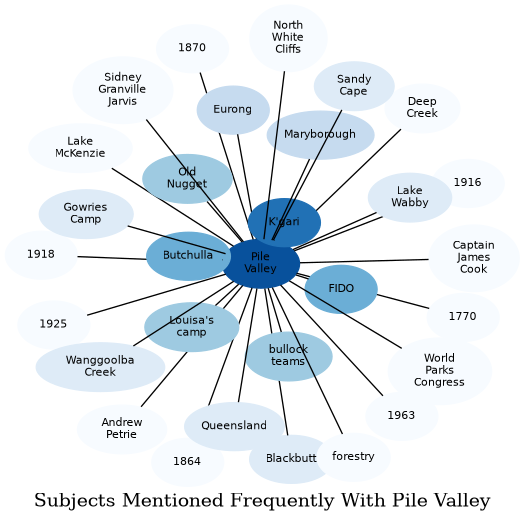Description
USC179_0004
The area which is now known as Pile Valley, at the head of Wool[crossed out and letter inserted above: n] goolvber Creek, we used to refer to as the "Turpentine Patch".
USC184_0003
John: The old teamsters used to always regard some areas as being xxxxxxxxx of special beauty on the island. Like that area there, at the head of Woolgoolver Creek. S.J: Yah, well it only got that name Pile Valley, it was just the head of Woolgoolvber Creek. Turpentine Patch, you see, we'd call it..Turpentine Patch. Bluckbutt, it all seemed to have its patches of timber.
USC295_0005
I, myself, hauled piles for the Granville bridge. The area which is now known as Pile Valley, at the head of Woongoolvba Creek we used to refer as the "Turpentine Patch".
USC617_0002
About 1925, a previously ignored tree, satinay (or turpentine) began to win world renown for its straight cylindrical trunks, over 30 metres long, which were resistant to marine borer attack. Some of Fraser's satinay was used for sidings in the Suez Canal. You can find excellent examples of this tall, straight tree in Pile Valley near Central Station.
USC617_0004
[map annotation]
1925 Satinay trees began winning world renown. Good examples of satinays are still found in Pile Valley today.
Pile Valley
USC935_0001
Fraser Island felt little impact from Cyclone Marcia. There was heavy rain for only one day (12th February), but during that event thousands of tonnes of loose sand that had been churned up on the roads by buses and other 4WDs in previous weeks were scoured downhill. This was the scene at the crossroads between Central Station and Pile Valley
Related Subjects

The graph displays the other subjects mentioned on the same pages as the subject "Pile Valley". If the same subject occurs on a page with "Pile Valley" more than once, it appears closer to "Pile Valley" on the graph, and is colored in a darker shade. The closer a subject is to the center, the more "related" the subjects are.